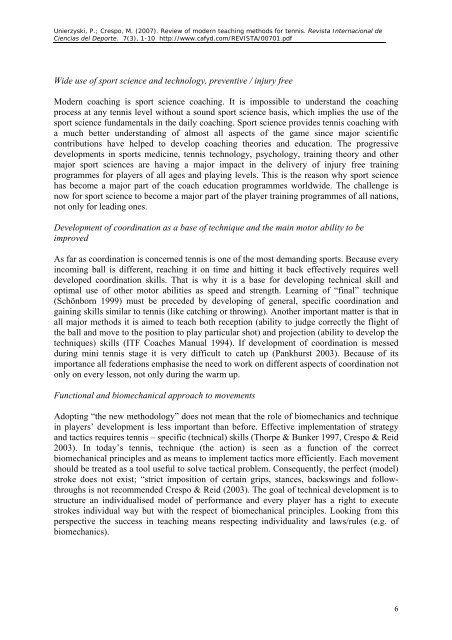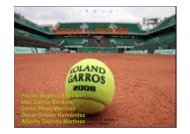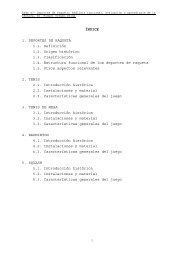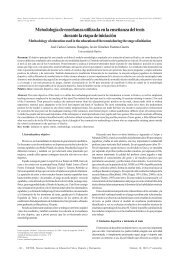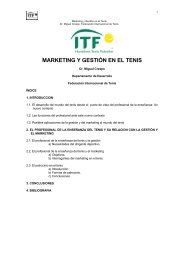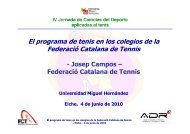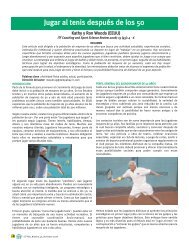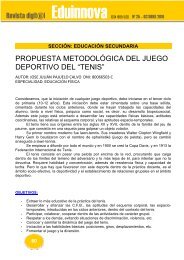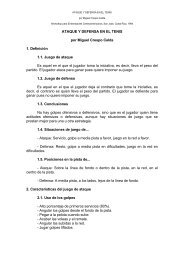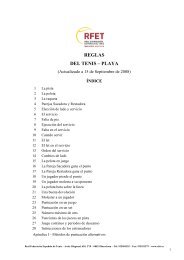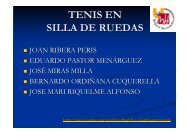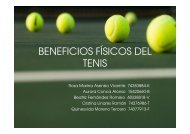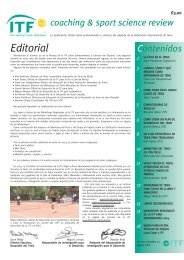Review of modern teaching methods for tennis ... - Miguel Crespo
Review of modern teaching methods for tennis ... - Miguel Crespo
Review of modern teaching methods for tennis ... - Miguel Crespo
You also want an ePaper? Increase the reach of your titles
YUMPU automatically turns print PDFs into web optimized ePapers that Google loves.
Unierzyski, P.; <strong>Crespo</strong>, M. (2007). <strong>Review</strong> <strong>of</strong> <strong>modern</strong> <strong>teaching</strong> <strong>methods</strong> <strong>for</strong> <strong>tennis</strong>. Revista Internacional deCiencias del Deporte. 7(3), 1-10 http://www.cafyd.com/REVISTA/00701.pdfWide use <strong>of</strong> sport science and technology, preventive / injury freeModern coaching is sport science coaching. It is impossible to understand the coachingprocess at any <strong>tennis</strong> level without a sound sport science basis, which implies the use <strong>of</strong> thesport science fundamentals in the daily coaching. Sport science provides <strong>tennis</strong> coaching witha much better understanding <strong>of</strong> almost all aspects <strong>of</strong> the game since major scientificcontributions have helped to develop coaching theories and education. The progressivedevelopments in sports medicine, <strong>tennis</strong> technology, psychology, training theory and othermajor sport sciences are having a major impact in the delivery <strong>of</strong> injury free trainingprogrammes <strong>for</strong> players <strong>of</strong> all ages and playing levels. This is the reason why sport sciencehas become a major part <strong>of</strong> the coach education programmes worldwide. The challenge isnow <strong>for</strong> sport science to become a major part <strong>of</strong> the player training programmes <strong>of</strong> all nations,not only <strong>for</strong> leading ones.Development <strong>of</strong> coordination as a base <strong>of</strong> technique and the main motor ability to beimprovedAs far as coordination is concerned <strong>tennis</strong> is one <strong>of</strong> the most demanding sports. Because everyincoming ball is different, reaching it on time and hitting it back effectively requires welldeveloped coordination skills. That is why it is a base <strong>for</strong> developing technical skill andoptimal use <strong>of</strong> other motor abilities as speed and strength. Learning <strong>of</strong> “final” technique(Schönborn 1999) must be preceded by developing <strong>of</strong> general, specific coordination andgaining skills similar to <strong>tennis</strong> (like catching or throwing). Another important matter is that inall major <strong>methods</strong> it is aimed to teach both reception (ability to judge correctly the flight <strong>of</strong>the ball and move to the position to play particular shot) and projection (ability to develop thetechniques) skills (ITF Coaches Manual 1994). If development <strong>of</strong> coordination is messedduring mini <strong>tennis</strong> stage it is very difficult to catch up (Pankhurst 2003). Because <strong>of</strong> itsimportance all federations emphasise the need to work on different aspects <strong>of</strong> coordination notonly on every lesson, not only during the warm up.Functional and biomechanical approach to movementsAdopting “the new methodology” does not mean that the role <strong>of</strong> biomechanics and techniquein players’ development is less important than be<strong>for</strong>e. Effective implementation <strong>of</strong> strategyand tactics requires <strong>tennis</strong> – specific (technical) skills (Thorpe & Bunker 1997, <strong>Crespo</strong> & Reid2003). In today’s <strong>tennis</strong>, technique (the action) is seen as a function <strong>of</strong> the correctbiomechanical principles and as means to implement tactics more efficiently. Each movementshould be treated as a tool useful to solve tactical problem. Consequently, the perfect (model)stroke does not exist; “strict imposition <strong>of</strong> certain grips, stances, backswings and followthroughsis not recommended <strong>Crespo</strong> & Reid (2003). The goal <strong>of</strong> technical development is tostructure an individualised model <strong>of</strong> per<strong>for</strong>mance and every player has a right to executestrokes individual way but with the respect <strong>of</strong> biomechanical principles. Looking from thisperspective the success in <strong>teaching</strong> means respecting individuality and laws/rules (e.g. <strong>of</strong>biomechanics).6


